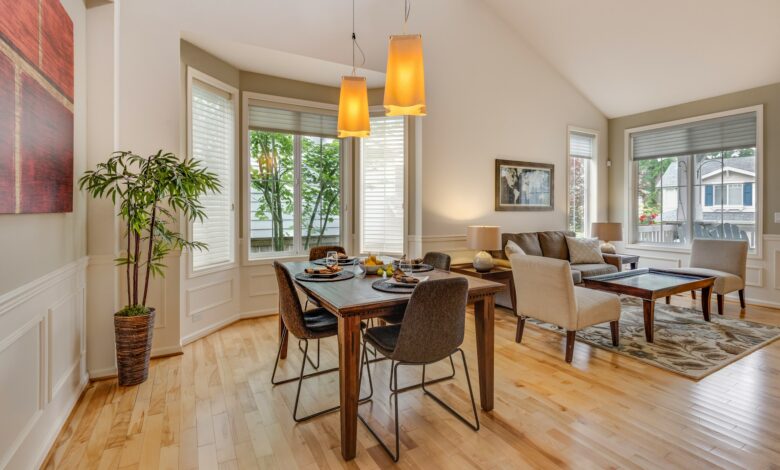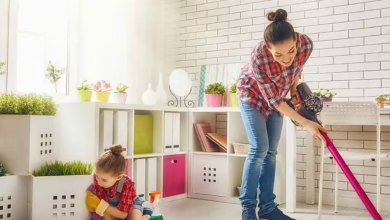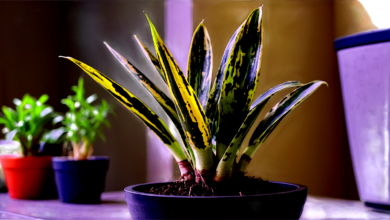How to Choose the Perfect Flooring for Every Room

Have you ever wondered why some rooms feel warm and inviting while others seem cold or awkward? A big part of that feeling comes from the flooring. Choosing the right floor for each room can make your home more comfortable, beautiful, and practical.
Each room has its own purpose and design needs. By picking the right flooring, you can connect your home’s style while making every space work better. In this guide, we’ll help you explore how to match flooring to function, style, and materials, one room at a time.
Living Room: Comfort and Style in One Space
The living room is the heart of the home. It’s where families gather to relax, entertain guests, or watch a movie. That’s why flooring in this room needs to balance comfort, durability, and style. Carpet is a popular choice for its softness and sound-reducing quality, which makes the room feel cozy and helps create a relaxing atmosphere.
Hardwood is another great option for the living room. It offers a timeless look and adds value to your home. You can choose between lighter and darker shades, depending on your home’s color scheme. Area rugs can be used over hardwood floors to add warmth without giving up the wood’s classic appeal.
Luxury vinyl is also a smart choice. It looks like real wood or stone but is softer underfoot and easier to maintain. It resists scratches and stains, making it a practical option for families with kids or pets. It comes in many styles and finishes, so you can find one that fits your living room theme.
Function is just as important as style. Choose flooring that can handle foot traffic while staying beautiful. Also, think about how sunlight affects your floor.
Some materials fade over time if exposed to too much light. UV-resistant finishes can help prevent this. Whether you want a warm, carpeted feel or a sleek wooden look, your living room flooring should reflect how you live and what makes you feel at home.
Kitchen: Durability and Cleanliness Are Key
The kitchen is one of the busiest areas in the house. Spills, splashes, and crumbs are common, so the floor must be easy to clean and strong enough to handle daily use. Tile is a classic kitchen flooring choice because it’s waterproof and easy to wipe clean. Ceramic or porcelain tile can match any design, from modern to rustic.
Laminate flooring is another popular choice for kitchens. It can mimic wood or stone at a lower cost. Newer versions are water-resistant, making them more suitable for kitchens than before.
They’re also easier on your feet than tile, which can be hard and cold. If you want something even softer, try cork flooring-it’s eco-friendly and naturally water-resistant when sealed properly.
Vinyl flooring works well in kitchens too. It’s affordable, water-resistant, and softer than tile or wood. Sheet vinyl is great for a smooth, waterproof surface, while luxury vinyl tiles or planks provide a high-end look with added comfort and strength. Vinyl also offers many design choices, so you don’t have to sacrifice beauty for function.
Consider how long you spend standing in your kitchen. Floors with some “give” can help reduce strain on your legs and back. Anti-fatigue mats may help, but selecting the right floor material also makes a difference.
Kitchens also face a lot of traffic, so choose a surface that resists wear and tear. Your kitchen floor should stand up to messes and moisture while looking clean and stylish.
Bedroom: Softness and Warmth First
Bedrooms are meant for rest and relaxation. The flooring in this room should feel warm and soft, especially when you get out of bed in the morning. Carpet is a top choice for bedrooms because it adds coziness and absorbs sound. It’s available in many textures, colors, and styles, letting you personalize your space easily.
Another option is hardwood. Though not as soft as carpet, it adds elegance and natural warmth. You can make the floor more comfortable by using large rugs near the bed or under furniture.
Hardwood works well in both traditional and modern bedroom designs. It’s also easy to clean and doesn’t trap dust or allergens like carpet might.
Engineered wood is a good alternative to solid hardwood. It offers a similar look but is more stable in changing temperatures or humidity levels. If you want the appearance of wood with added comfort, luxury vinyl plank flooring can be a great pick. It’s softer and warmer underfoot while being budget-friendly and long-lasting.
Cork is another interesting choice for bedrooms. It’s quiet, soft, and naturally warm. It also resists mold and mildew, which is ideal for allergy sufferers. Choose a material that matches how you use the space.
If your bedroom is your personal retreat, focus on comfort and warmth. For guest rooms, go for easy-to-clean and versatile flooring that still feels welcoming.
Style also matters. Match the flooring to your wall color, furniture, or even the mood you want to create. Soft pastels and wood floors give a calm feel, while bold carpets can make the room stand out. In the bedroom, comfort is key, but with the right material, you don’t have to give up style.
Bathroom: Waterproof and Slip-Resistant Options
Bathrooms have unique needs when it comes to flooring. Water, humidity, and changing temperatures are common, so your flooring must be waterproof and easy to clean. Tile is the most popular choice.
Ceramic and porcelain tiles resist water and come in many shapes, sizes, and colors. You can create a simple look or something more decorative with patterns and textures.
Stone tile, like slate or marble, offers a natural and elegant look. These materials are more expensive and need sealing to stay water-resistant. However, they are very strong and add luxury to your bathroom. For a safer option, choose textured tiles that reduce the risk of slipping when the floor is wet.
Vinyl flooring is a smart and budget-friendly choice for bathrooms. Both sheet vinyl and luxury vinyl tile offer water protection, comfort, and style. They can mimic the look of more expensive materials while being softer and warmer underfoot. They’re also easier to install and replace if needed.
Another option is waterproof laminate, though not all types are suitable for bathrooms. If you pick this, make sure it’s labeled for high moisture areas. Some newer products are made to resist spills, but always check the manufacturer’s recommendations before choosing.
Safety and maintenance should guide your choice. Smooth, glossy tiles may look nice, but can be dangerous when wet. Always select flooring with a non-slip surface or add bath mats for extra protection.
Also, think about cleaning. Some floors need special care, while others can be mopped easily. The best bathroom flooring is safe, stylish, and stands up to moisture and daily use.
Entryway and Hallway: Tough and Inviting
Entryways and hallways often face the most foot traffic. These areas bring in dirt, moisture, and debris from outside, so the flooring must be strong and easy to maintain. Tile and stone are good choices because they resist scratches and moisture. They’re also easy to clean, which is helpful after rainy or muddy days.
If you prefer a warmer look, hardwood or engineered wood can work well. Choose a harder wood species, like oak or maple, to prevent dents and scratches. Use a strong finish to protect the surface, and place rugs or mats near doors to catch dirt before it spreads.
Luxury vinyl is another excellent option; it looks like wood or stone but is more durable and forgiving. It’s also water-resistant, which is great for areas where wet shoes or umbrellas are common. It comes in planks or tiles that are easy to install and clean. Luxury vinyl gives your hallway a polished, stylish look without the high cost.
Laminate flooring is also worth considering. It’s tough and resists wear, but not all versions are waterproof. Choose water-resistant laminate if your entryway tends to get wet. It also offers many design choices, from rustic to modern, so it can match any interior.
In terms of design, the hallway or entry should feel like a natural part of the home. Use flooring that ties in with nearby rooms to create a smooth visual flow. Add runners or rugs for color and softness, but make sure they’re secure to avoid slipping. Choose floors that look good, stay clean, and handle lots of movement every day.
Home Office: Balance Comfort and Professional Style
With more people working from home, the home office has become a key part of the house. Flooring here should support focus, reduce noise, and look professional. Carpet is great for reducing sound, which is helpful if you’re taking calls or attending virtual meetings. It also adds comfort, especially if you spend long hours at your desk.
If you prefer a cleaner, sleeker look, hardwood or laminate can work well. These surfaces are easy to clean and create a more polished, professional setting. Hardwood adds charm and value, while laminate gives you a similar look at a lower cost. Just add a small rug under your desk chair to protect the floor and add softness.
Luxury vinyl is another smart choice for a home office. It offers comfort underfoot, is easy to maintain, and can look like high-end materials without the high price. It also resists scratches and stains, which is helpful if you move your chair often or eat while working. Plus, it’s quieter than harder materials, which helps reduce echo.
Cork is a great option if you want something eco-friendly and quiet. It’s soft, naturally resists mold, and provides a warm feel. It’s perfect for focused, quiet workspaces where comfort is key. Cork flooring also absorbs sound, making the room feel peaceful and calm.
Think about your work habits and what environment helps you focus. Choose colors and textures that match your home’s design while keeping the space professional. With the right flooring, your home office can be both stylish and practical, a place where you feel productive and inspired every day.
Basement: Moisture-Resistant and Comfortable Choices
Basements are often tricky when it comes to flooring. They’re more likely to have moisture problems, so you need materials that resist water and mold. Avoid solid hardwood, which can warp in damp environments. Instead, go for tile, vinyl, or engineered wood designed for below-grade use.
Tile is great for basements because it’s water-resistant and easy to clean. It works especially well in finished basements that serve as game rooms, playrooms, or guest suites. However, tile can be cold, so consider using area rugs to make the space feel warmer.
Luxury vinyl plank or tile is one of the best options for basement flooring. It resists water, looks great, and feels more comfortable than stone or tile. Many homeowners use luxury vinyl to turn their basements into stylish living areas without the worry of moisture damage. It’s also available in many designs, so you can match the look to the rest of your home.
Engineered wood is another possible choice. It offers the look of hardwood with more moisture stability. It’s a good fit if your basement is dry and climate-controlled.
If you want warmth and sound control, carpet tiles are a good solution. They’re easy to install, and if one gets damaged, you can replace just that tile.
Don’t forget about subfloor preparation. A proper moisture barrier or underlayment helps prevent water damage and keeps floors warmer. Your basement can be a cozy and useful part of your home with the right flooring. Focus on comfort, safety, and long-term durability when choosing materials.
Choose the Perfect Flooring That Connects Every Space
Choosing the perfect flooring for every room doesn’t have to be difficult. Start by thinking about each room’s purpose and how much wear and tear it gets. Then, choose materials that support those needs without giving up on style.
Whether it’s the soft feel of carpet in the bedroom, the water resistance of vinyl in the kitchen, or the strong look of hardwood in the living room, each choice helps create a home that’s comfortable, cohesive, and personal.
Planning helps make your home more functional and attractive. Choosing the right flooring adds warmth, improves flow, and enhances each room’s functionality. While each room is unique, all deserve careful flooring choices.
Want to learn more? Explore other helpful guides and inspiring topics on our blog!




